The NVIDIA GeForce GTX 780 Ti Review
by Ryan Smith on November 7, 2013 9:01 AM ESTPower, Temperature, & Noise
As always, last but not least is our look at power, temperature, and noise. Next to price and performance of course, these are some of the most important aspects of a GPU, due in large part to the impact of noise. All things considered, a loud card is undesirable unless there’s a sufficiently good reason – or sufficiently good performance – to ignore the noise.
| GeForce GTX 780 Series Voltages | ||||
| GTX 780 Ti Boost Voltage | GTX 780 Boost Voltage | GTX 780 Ti Base Voltage | ||
| 1.187v | 1.1625v | 1.012v | ||
Taking a quick look at voltages, we find that our GTX 780 Ti operates at a slightly higher voltage at its maximum boost bin than the original GTX 780 did. The difference is minor, but the additional voltage may be necessary to hit the slightly higher clockspeeds GTX 780 Ti operates at relative to GTX Titan and GTX 780.
| GeForce GTX 780 Ti Average Clockspeeds | |||
| Max Boost Clock | 1020MHz | ||
| Metro: LL |
1000MHz
|
||
| CoH2 |
997MHz
|
||
| Bioshock |
954MHz
|
||
| Battlefield 3 |
980MHz
|
||
| Crysis 3 |
980MHz
|
||
| Crysis: Warhead |
1000MHz
|
||
| TW: Rome 2 |
950MHz
|
||
| Hitman |
993MHz
|
||
| GRID 2 |
967MHz
|
||
| Furmark |
823MHz
|
||
Moving on to clockspeeds, we find that the GTX 780 Ti does very well when it comes to boosting. With a maximum boost clock of 1020MHz, we have 2 benchmarks averaging 1000MHz, and another 4 averaging 980MHz or better.
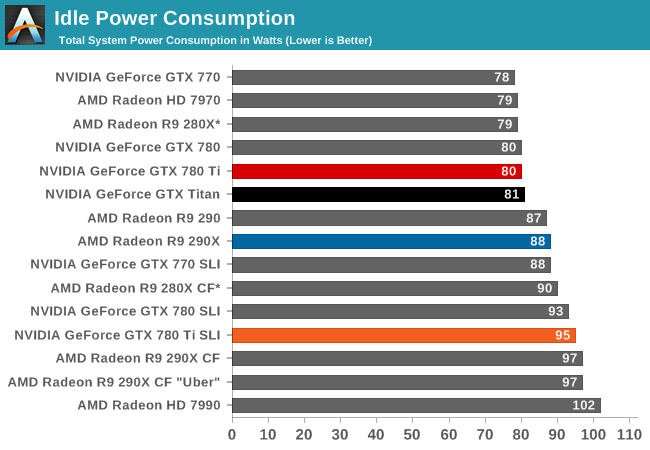
With all of our GK110 cards sharing a common design, at idle there’s very little to differentiate them. Other than GTX Titan’s extra 3GB of VRAM, we’re essentially looking at identical cards when idling.
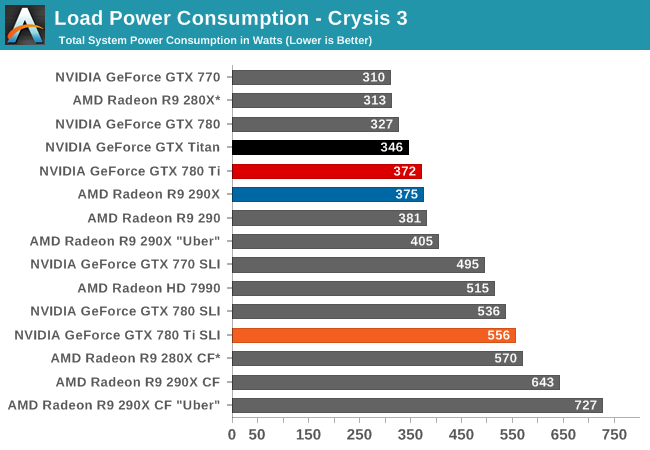
Moving on to load power, we can see the power/heat ramifications of the slight clockspeed increase coupled with the activation of the 15th SMX. Even with the further optimizations NVIDIA has put into the new revision of GK110, power consumption has gone up in accordance with the higher performance of the card, just as we’d expect. Since NVIDIA doesn’t notably alter their power efficiency here, that increased performance has to come at the cost of increased power consumption. Though in this benchmark it’s worth pointing out that we’re measuring from the wall and that GTX 780 Ti outperforms GTX Titan by 8%, so some of that 29W power difference will come from the higher CPU load caused by the increased framerates.
As for the GTX 780 Ti SLI, here we see power level off at 556W, 20W more than the GTX 780 SLI. Some (if not most) of that is going to be explained by the increased CPU power consumption from the GTX 780 Ti SLI’s higher framerates. Coupled with that is the fact that in SLI setups these cards get hotter, and hence have to downclock a bit more to maintain equilibrium, which helps to offset the increased power requirements of GTX 780 Ti and keep the SLI results so close to the GTX 780 SLI results.
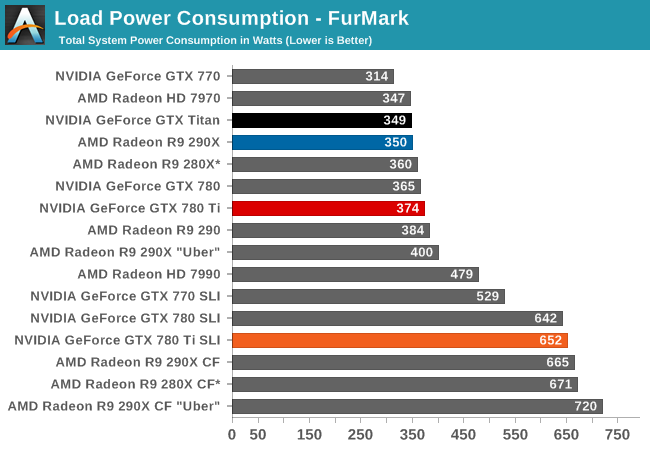
Switching over to FurMark, we find that power consumption is also up, but only slightly. With GPU Boost 2.0 clamping down on power consumption all of our GK110 cards should be clamped at 250W here, and with a difference between GTX 780 and GTX 780 Ti of under 10W, that’s exactly what appears to be happening here.
On a side note, it’s interesting to note here that under FurMark we’re seeing the GTX 780 Ti draw more power than the Radeon R9 290X. Despite the fact that the 290X has a higher rated TDP, in the card’s default quiet mode the card can’t actually dissipate as much heat (and thereby consume as much power) as the GTX 780 Ti can.
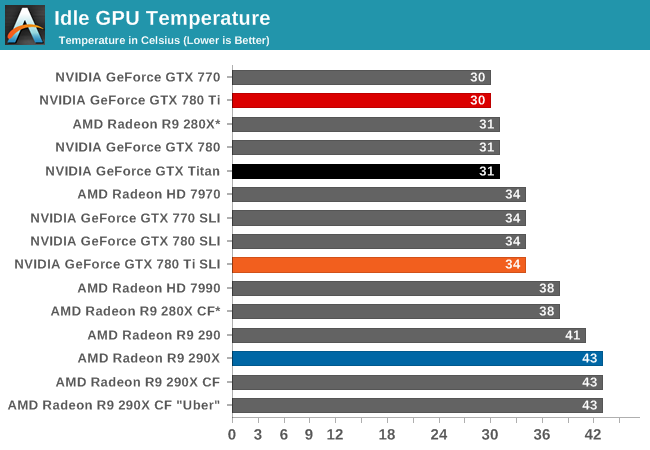
For idle temperatures we’re once again looking at cards that are for all intents and purposes identical. At 30C the GTX 780 Ti easily stays nice and cool.
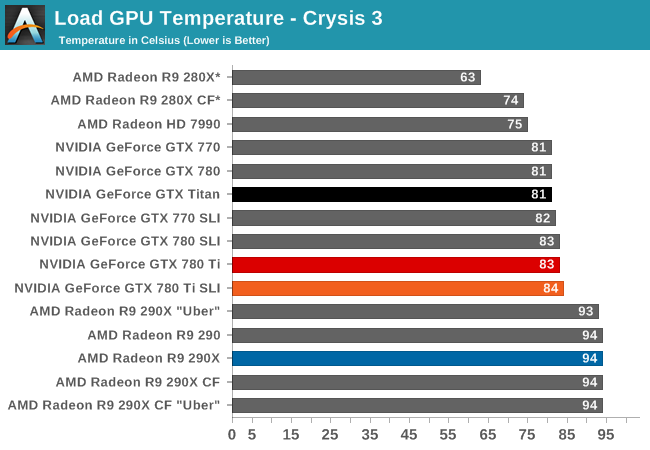
As we mentioned in our look at the GTX 780 Ti hardware, NVIDIA has increased their default temperature throttle point from 80C on the GTX Titan/780 to 83C on the GTX 780 Ti. The end result is that in all of our temperature limited tests the GTX 780 Ti will peak at 83C-84C, whereas the older GK110 cards will peak at 80C-81C.

FurMark reiterates what we saw with Crysis 3. The temps are up a bit across the board, while the GK110 cards are holding near their throttle points. The SLI setups meanwhile approach the upper-80s at 88C, reflecting the fact that even with blowers, there’s some impact on neighboring cards in high load situations.
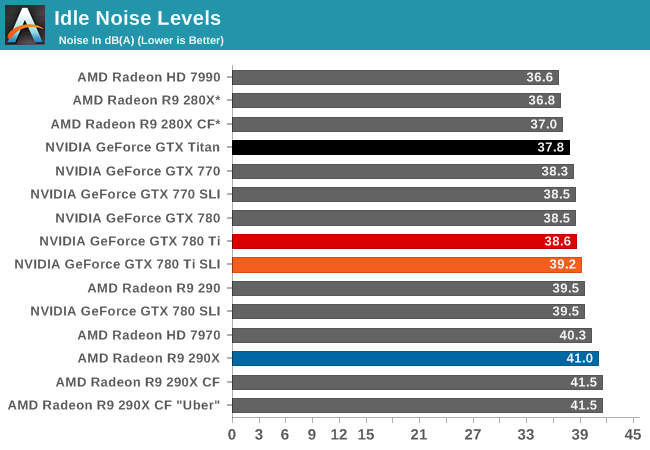
Our last idle scenario, we once again see all of our GK110 cards performing similarly, with idle noise levels in the 38dB-39dB range.
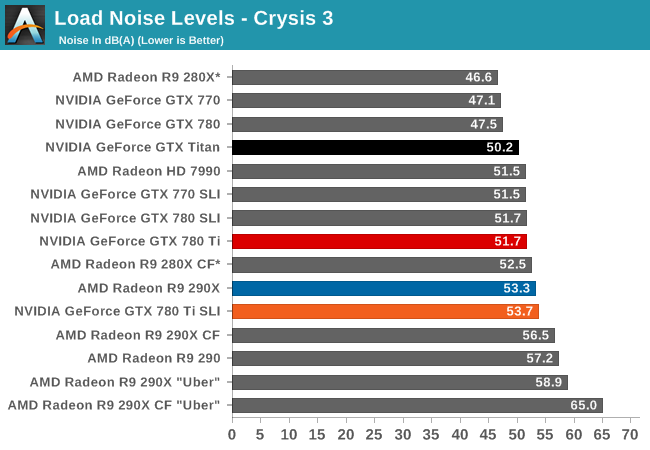
Moving on to our gaming load noise results, we can see the full repercussions of the GTX 780 Ti’s higher average power consumption coupled with the card’s higher temperature throttle point. Moving the throttle point along the same curve has the end result of moving higher the equilibrium point and thereby the card’s operating noise levels. As the fastest single-GPU card on this card, the GTX 780 Ti is still doing very well for itself and for a blower based design at 51.7dB, though at 1.5dB louder than GTX Titan and 4.2dB louder than GTX 780 the noise tradeoff for the card’s higher performance is very clear. Meanwhile the fact that it’s tied with the GTX 780 SLI comes with its own bit of irony.
Speaking of the GTX 780 SLI, we can see the noise impact of SLI configurations too. The GTX 780 Ti SLI levels out at 53.7dB, 2dB louder than our single-card configuration and 2dB louder than the GTX 780 SLI. At this point it’s just a bit louder than the 290X and quieter than a number of other 290 series setups.
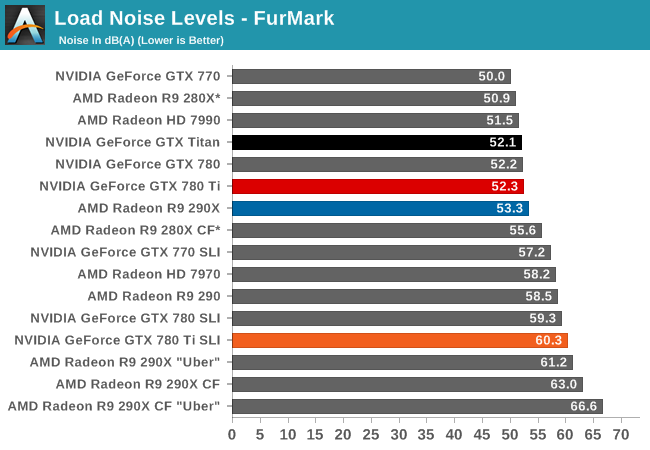
Finally with load noise levels under FurMark we can see where our various cards will peak at for noise levels. The GTX 780 Ti creeps up to 52.3dB, essentially tying with the GTX 780 and GTX Titan. Otherwise it comes in just behind the 290X, and the start of the pack for our multi-GPU setups.
As for the GTX 780 Ti SLI, like our single-card comparison points its up slightly as compared to the GTX 780 SLI.
Overall, our look at power, temperatures, and noise has been a rather straightforward validation of our earlier suspicions. GTX 780 Ti’s higher performance leads to higher power consumption, and will all other factors being held equal – including the cooler – power, temps, and noise levels all rise a bit as compared to GTX Titan and GTX 780. There’s no such thing as a free lunch here, and while GPU Boost 2.0 will keep the maximum levels suitably in check, on average GTX 780 Ti is going to be a bit worse than the other GK110 cards due to those factors. Though even with the increased noise levels in particular, GTX 780 Ti is still able to outperform 290X on noise while also delivering better gaming performance, which makes this another tidy victory for NVIDIA.










302 Comments
View All Comments
mohammadm5 - Monday, November 11, 2013 - link
http://www.aliexpress.com/item/Wholesale-Price-GeF...thats the wholesale price its not nvidia that charges so much is the resellers. the profit nvidia makes per gpu is very low but the reseller make alot of money, also the new amd r9 290 is going for $255 per unit at wholesale price and the r9 280x is going for $160 dollar per unit. you have to also remember thats the distributer price not the manufacturer price,witch should be alot lower. i know the gtx 780 at manufacturer price sells from $200 to $280 depending on brand.
so remember this is america were they sell you something made in china for 1 dollar for 10 dollars
UpSpin - Monday, November 11, 2013 - link
While those numbers are interesting, your conclusion is wrong. The $700 are what NVidia wants the customer to pay for the card, not what the reseller wants:http://nvidianews.nvidia.com/Releases/NVIDIA-Unvei...
"Pricing is expected to start at $699"
So it's not the seller who makes 100% profit, it's NVidia.
polaco - Monday, November 11, 2013 - link
remember that the reseller has to buy the card, pay import taxes, transportation and others, try to sell it and if the card goes unsold they have to sell it in a few month at discounts prices. Also in the case of psychical stores they have to keep building costs, employees, more taxes, etc. So what you are describing happens in every industry. Also and maybe in first place where are you getting those numbers from?Wade_Jensen - Monday, November 11, 2013 - link
OK, so either Brian has lost his Nexus 5 or its benchmark boosting, cause something has to be going on here.beck2448 - Monday, November 11, 2013 - link
Wow oc results are impressive. Where are the Lightning and Windforce versions?r13j13r13 - Tuesday, November 12, 2013 - link
la ventaja frente a una 290x es mínima pero la diferencias de precio no cuando se mejore la refrigeración de la 290x, al fin y al cabo la competencia nos beneficia a todosjukkie - Tuesday, November 12, 2013 - link
HD7990 can be gotten for as low as £400 in the UK at the moment (or £480 with a PSU or a M/B), so anyone wanting the ultimate in single CARD performance would bet better off buying that anyway.Obviously noise and heat will still be an issue, but if you're going to ignore the GTX 780 Ti's price, we can ignore those factors (thankfully microstuttering is mostly a non-issue these days since frame pacing has resolved that in everything except DX9 for now).
If the price of the 780 Ti were to drop 10-20%, I'd consider buying one, but as it is I simply can't justify it, even if affording it isn't a problem.
arjunp2085 - Wednesday, November 13, 2013 - link
Anand / RyanI would love to see a comparison of the 290 , 290x 780, 780 Ti with water coolers working efficiently. I believe that anyone spending $600 on a Gfx card would be able to spend an additional 100-200$ for a cool setup.
Further i would love to see if there is any performance increase due to increased cooling( With respect to boost states both Nv and AMD.
Any comments please let me know
Thanks,
Arjun
GUNN3R - Friday, November 29, 2013 - link
Is there an update in scores with latest drivers?Hrel - Sunday, January 12, 2014 - link
I really wish you guys had included useful resolutions. You realize the VAST majority of people, even enthusiasts, have 1080p screens right?You can do ur uber testing for your own personal concerns but it should be standing policy to include 1080p testing for everything. That's the resolution of screen that people have.